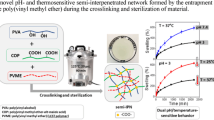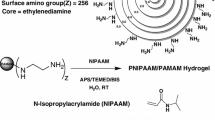Abstract
Purpose. The purpose of this work was to study solute (drug and protein)/polymer interactions that affect solute diffusion in and subsequent release from swellable dosage forms based on environmentally responsive, pH-sensitive polymer networks.
Methods. Ionizable pH-sensitive hydrogels were synthesized by free-radical polymerization of acrylic acid (AA) and 2-hydroxyethyl methacrylate (HEMA) with ethylene glycol dimethacrylate as crosslinking agent. The degree of crosslinking and degree of hydrophilicity were controlled by varying the relative concentration of crosslinking agent and comonomer, respectively. The role of solute distribution within the hydrogels as related to the transport behavior was investigated by Fourier transform infrared (FTIR) microscopy.
Results. The solute-loaded hydrogels were cryotomed into 4 µm thin sections. The concentration profile of the solute was constructed from the two dimensional intensities measured by monitoring the infrared vibrational band indicative of that compound in the x and y direction. These studies indicated that the model solute, oxprenolol HC1, was evenly distributed throughout the bulk and surface of the hydrogel samples. Solute/polymer interactions were investigated as a function of the polymer composition and swelling media pH. The concentration profiles of oxprenolol HC1 solution loaded into PAA and P(AA-co-HEMA) hydrogels were analyzed by scanning electron microscopy by FTIR microscopy. For hydrophilic polymers (hydrogels) containing ionizable pendant groups, the molecular weight between crosslinks, the degree of swelling, and the degree of ionization were altered by local changes in pH and ionic strength.
Conclusions. The data demonstrated that it is possible to evaluate the polymer/solute interactions by using FTIR microscopy.
Similar content being viewed by others
REFERENCES
O. Wichterle and D. Lim. Hydrophilic gels for biological use. Nature, 185:117–118 (1960).
F. G. Hutchinson. Development in ionic polymer-2. In A. D. Wilson and H. J. Prosser (eds.), Application of Ionic Polymers in Medicine, Elsevier Applied Science, London, 1986, pp. 303–327.
S. H. Gehrke and P. I. Lee. Hydrogels for drug delivery systems. In P. Tyle (ed.), Specialized Drug Delivery Systems, Marcel-Dekker, New York, 1990, pp. 333–392.
B. D. Ratner and A. A. Hoffman. Synthetic hydrogels for biomedical applications. In J. D. Andrade (ed.), Hydrogels for Medical and Related Applications, ACS Symposium Series, American Chemical Society, Washington, D.C., 1976, vol. 31, pp. 1–36.
R. Langer and N. Peppas. Chemical and Physical Structure of Polymers as Carriers for Controlled Release of Bioactive Agents: A Review, J. Macrom. Sci., Revs. Macrom. Chem. Phys., C23: 61–126 (1983).
P. I. Lee. Effect of non-uniform initial drug concentration distribution on the kinetics of drug release from glassy hydrogel matrices. Polymer, 25:973–978 (1984).
P. I. Lee. Novel approach to zero-order drug delivery via immobilized nonuniform drug distribution in glassy hydrogels. J. Pharm. Sci., 73:1344–1347 (1984).
S. R. Sandler and W. Karo. Polymer Synthesis, Vol. 2, Academic Press, New York, NY, 1977.
V. Carelli, G. Di Colo, E. Nannipieri, and M. F. Serafini. Evaluation of the solution impregnation method for loading drugs into suspension-type polymer matrices: a study of factors determining the patterns of solid drug distribution in matrix and drug release from matrix. Intern. J. Pharm., 55:199–207 (1989).
H. J. Humecki. Polymers and contaminants by infrared microspectroscopy. In R. G. Messerschmidt and M. A. Harthcock (eds.), Infrared Microspectroscopy: Theory and Applications. Dekker, New York, NY, 1988, pp. 51–72.
P. R. Griffiths and J. A. de Haseth. Fourier Transform Infrared Spectrometry. Wiley & Sons New York, NY, 1986, p. 183.
J. J. Sahlin. Polymer Chain Interdiffusion in Gel/Gel Adhesion. Purdue University, School of Chemical Engineering, Ph.D. Thesis, May 1992.
M. T. am Ende. Transport and interaction of ionizable drugs and proteins in hydrophilic polymers. Ph.D. Thesis, Purdue University, School of Chemical Engineering, December, 1993.
P. R. Thorton. Scanning Electron Microscopy: Applications to Materials and Device Science. Chapman and Hall Ltd, London, 1968, p. 17.
Rights and permissions
About this article
Cite this article
Ende, M.T.a., Peppas, N.A. Analysis of Drug Distribution in Hydrogels Using Fourier Transform Infrared Microscopy. Pharm Res 12, 2030–2035 (1995). https://doi.org/10.1023/A:1016224813626
Issue Date:
DOI: https://doi.org/10.1023/A:1016224813626




